Homeowners’ Guide to Stucco Remediation
Stucco is popular with homeowners for good reason.
It’s tough, fire-resistant, and versatile, not to mention attractive. However, although stucco is tough and durable, it’s not invincible. It can develop cracks if the foundation beneath your house settles, and because it’s so porous, it’s prone to water damage.
What can you do when your stucco is beyond repair?
At Choice Exteriors we'd like to put our years of experience to work and tell you about stucco remediation. In this guide, you will learn everything you need to know about stucco remediation.
Are you ready to dive in?
Let’s get started.
What Is Stucco Remediation?
First, let’s explore what stucco remediation is and how it could benefit you as a homeowner. To do that, we need to first understand what stucco is.
What is stucco?
Typically found in drier climates such as the American southwest, stucco is a building material made from a mixture of Portland cement, sand, and water. This mixture makes a tough plaster you can spread on the exterior of a home. Sometimes builders add acrylics, lime, or glass fibers to the mixture to improve the structure.
Builders use this plaster to coat a house for weather-proofing and aesthetics, just like vinyl siding, stone, or brick. They can apply it as 3-coat stucco, which goes on in three layers overtop of a base of wire mesh and weatherproofing, or as 1-coat stucco, which is just one coat overtop of the whole house. One coat stucco is much cheaper and quicker but more prone to damage.
Pros and cons of stucco
Stucco is a popular choice with homeowners, particularly in the southwest or any dry region. That is because it has a number of advantages. However, like any building material, it has its drawbacks too.
Some of the advantages of stucco include:
- Cheap
- Quick to install
- Energy efficient
- Good insulator
- Beautiful
However, as we said, stucco has its drawbacks.
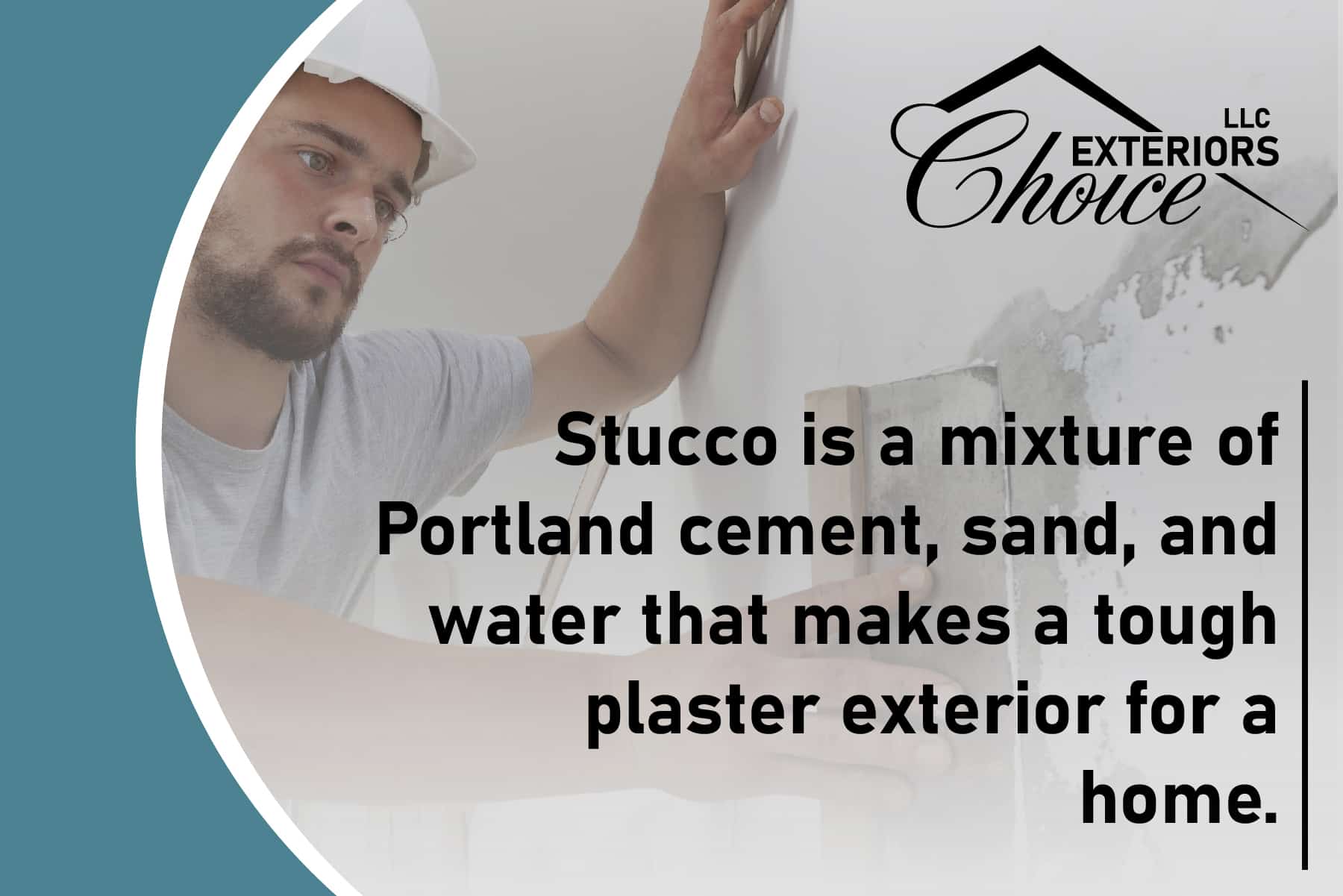
Stucco homes are basically encased in a layer of stiff concrete, and if your house shifts much, the stucco can easily crack and break.
Also, stucco is designed to allow moisture to pass through it. In warm, dry climates this is a good thing because it allows moisture to escape from behind the stucco so the wall cavity dries out. However, in damp, cool climates like the northeast, this permeability can make stucco prone to water damage because it may never dry out.
Unfortunately, stucco water damage can lead to mildew and mold, ugly stains on your home’s exterior, and even deeper issues such as wall rot.
What is stucco remediation?
So what do you do when your stucco degenerates beyond repair?
That is where stucco remediation comes in.
Stucco remediation is simple—it’s the process of tearing off all the old stucco and replacing it with upgraded stucco or siding such as James Hardie Siding.
The difference between stucco remediation and stucco repair is that stucco remediation fixes the underlying issues, not just surface damage. With repair, you simply fix the outer issues, whereas, with remediation, you completely remove all the faulty stucco and replace it with something better.
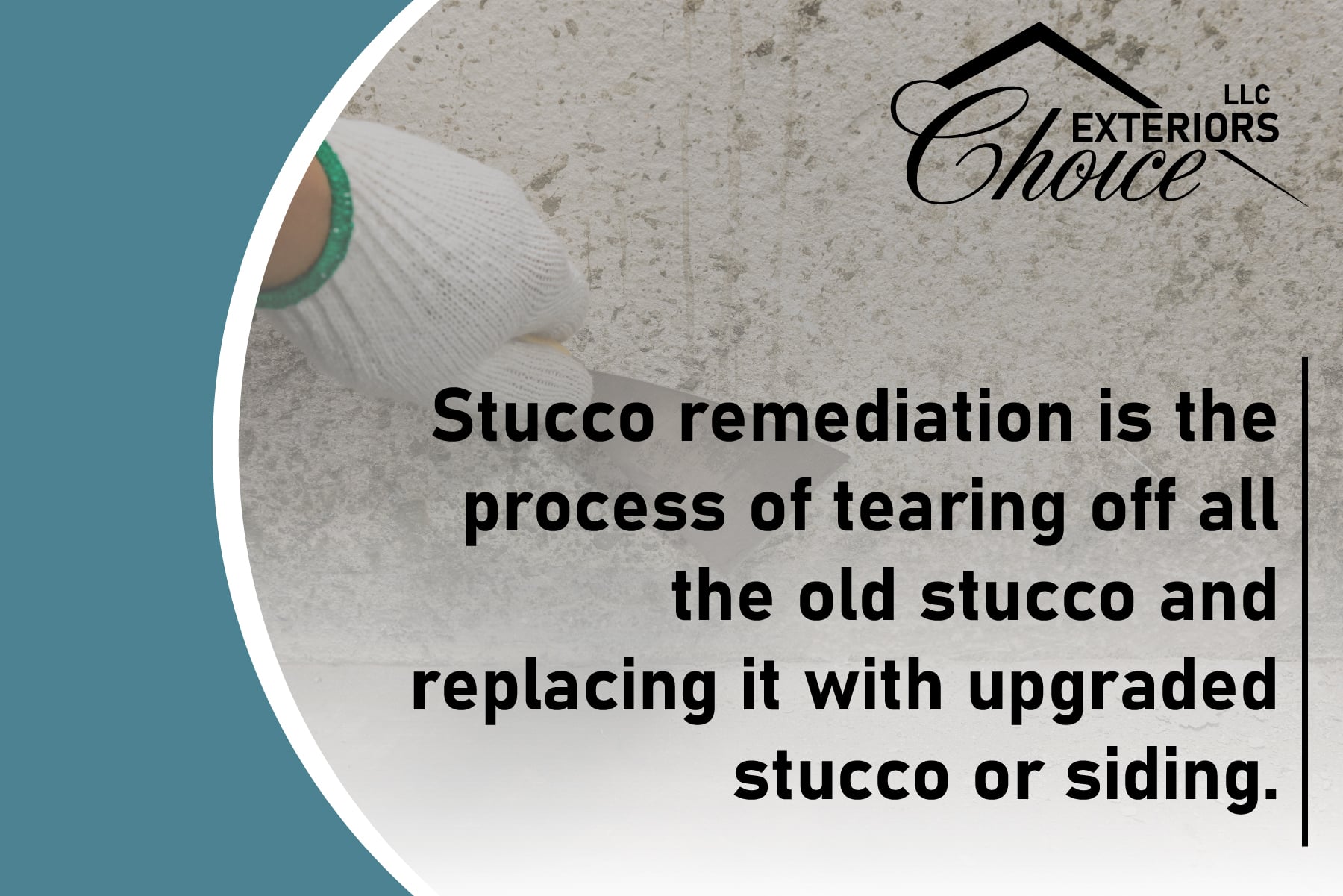
Benefits of stucco remediation
If you perform stucco remediation, what are you going to gain? After all, you will have to shell out money for the project. You want to know exactly how it’s going to benefit you!
Here are a few of the main benefits of stucco remediation:
- Stucco remediation addresses the root issues rather than fixing the surface ones. If stucco repair is like patching a tire, then stucco remediation is like buying a brand new tire that is in top-notch condition. Because it fixes the root issues, the results of stucco remediation will last much longer than those of stucco repair.
- Stucco remediation allows you to update and upgrade your home’s appearance. You could stick with the same color and siding type you had before, or you could upgrade to something better and even switch from stucco to a different kind of siding.
- Remediation protects the rest of your home from further damage, whereas if you simply repair, the problems could go deeper and cause more damage over time. And, unfortunately, if you ignore the problems, the damage could be significant--we are talking about things like toxic black mold, rotting framing, and water damage to the interior of your home!
Drawbacks of stucco remediation
Of course, stucco remediation has its drawbacks too. Here are a few things to consider before going all in with stucco remediation.
- Stucco remediation is more expensive than fixing surface issues.
- You will likely have a longer construction timeline with remediation.
- Remediation takes more skilled work than repair and is likely not DIY-able.
Remediation is a good idea in some situations, but not every single situation. You should always consider all the pros and cons before launching into any large construction project.
We will look at when you should and shouldn’t perform remediation in the next section.
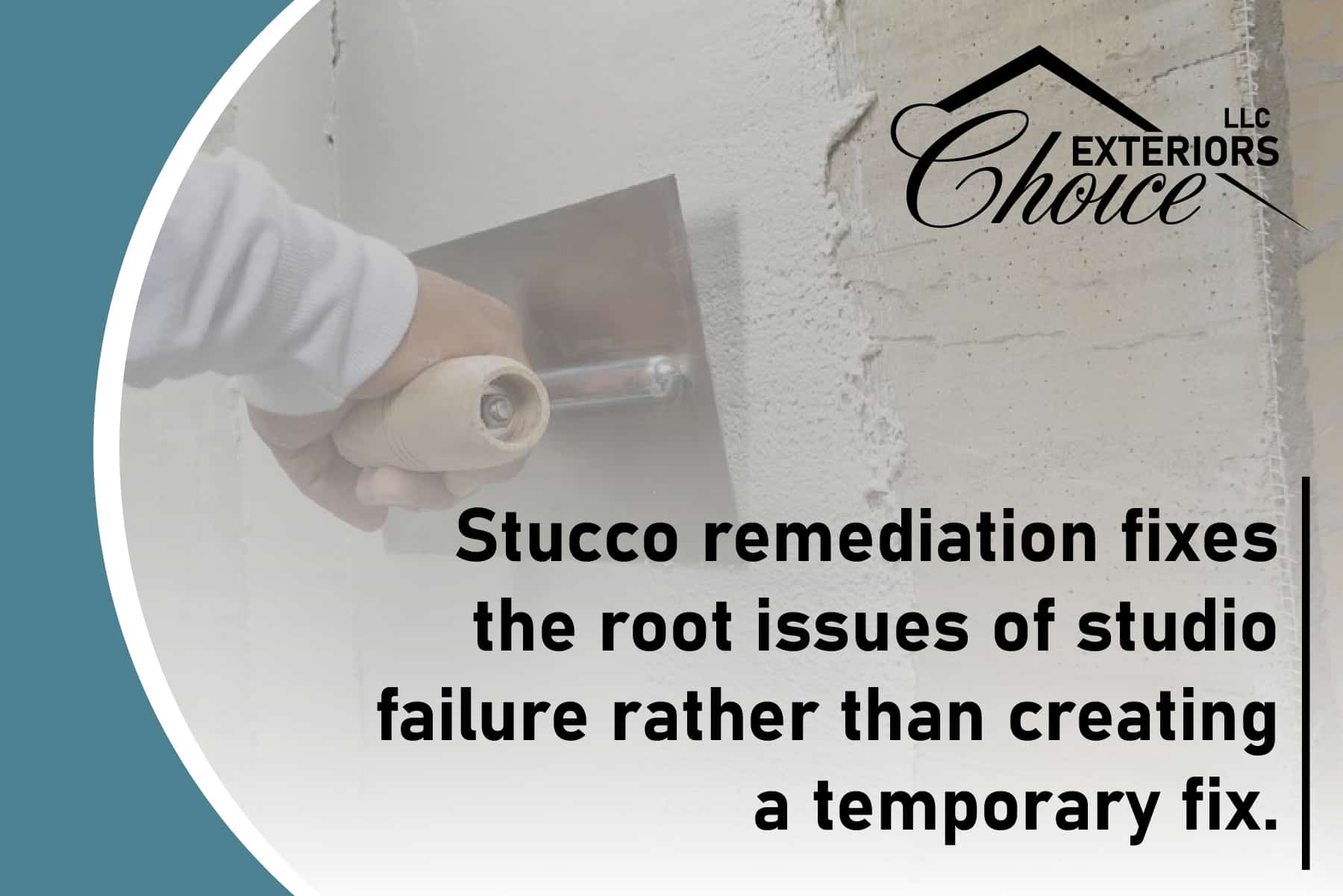
When Should You Perform Stucco Remediation
By this point, you have gotten the idea that stucco repair is a quick fix while stucco remediation is a complete overhaul. Now the question is, when do you need repairs, and when do you need remediation?
After all, you wouldn’t want to simply repair surface damage when you should perform a full redo, and you wouldn’t want to go to all the trouble of a complete makeover when all you need is some simple repairs.
In the next section, we’ll explore when and when not to perform stucco remediation.
Signs of stucco failure
Before you decide if you need remediation, you need to be aware of the state of your stucco and know whether it is failing or not.
If you own a stucco home, here are some red flags you should be on the lookout for. If you notice any signs of stucco damage, call a professional and get their opinion on the case.
-
Lasting water spots
It is OK for stucco to hold a little moisture, but if you see permanent water marks on your exterior walls, you may have serious issues. Moisture staining can look like white, hazy streaks, or dark blotches. When you leave the stains untreated, the trapped moisture can form nasty black mold and rotting wood, which can seriously compromise your home’s structure.
If you are suspicious of water damage, the first places you should check are around your doors and windows, as these are common places for water to seep into your stucco.
-
Cracking
Cracks can form in stucco for various reasons, such as shifting foundations, bad mixing proportions, and poor workmanship.
Small cracks in stucco are common and aren’t cause for significant concern. However, cracks larger than 1/16 of an inch can result in trapped water, which leads to mold and rot, just like water spots.
While you may be tempted to simply fix individual cracks, this isn’t always effective long-term because if the cracks are deep enough, water may have already seeped through and caused damage.
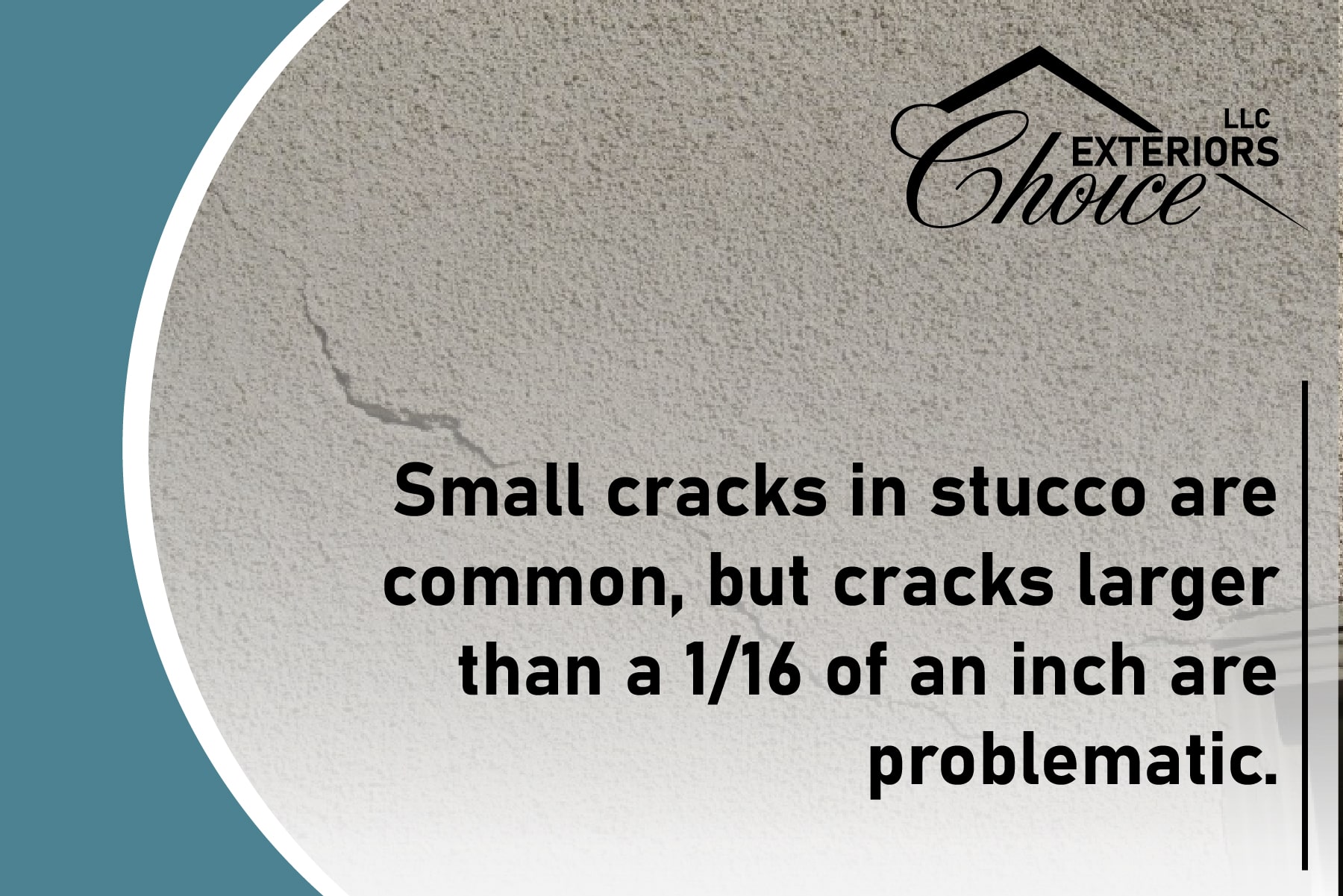
-
Below-grade stucco
When stucco is applied correctly, there should be at least two inches of clearance between the end of the stucco and the ground in order for the stucco to drain properly. In other words, you don’t want the layer of stucco to extend underground.
Stucco below the grade is a sign of bad workmanship, and it is a problem because underground stucco traps moisture and leads to cracking, rotting, and crumbling. The stucco may also start pulling moisture from the ground up into itself like a sponge, causing it to become wet even higher up.
-
Failing caulk
Caulking is applied around windows, trim, and doors to seal the joints along the seams. If caulking becomes dried and shrunken or is missing completely, water could enter and cause damage to your stucco and other materials. That can lead to the previously mentioned problems such as mold and rot.
Other places where caulking may fail include lighting, decks, and anywhere else where there is a joint or seam in the stucco where water could enter.
When to perform stucco remediation
If your stucco is relatively new and there are no small, spreading cracks or mold and moisture present, then minor repairs might be all the problem requires.You should only remediate when your stucco issues are caused by a major unseen issue. If your issues go deeper than the surface, they will keep coming back no matter how often you repair them.
Remediation is more expensive and time-consuming than repair, so it’s understandable not to want to commit to remediation if you don’t have to.
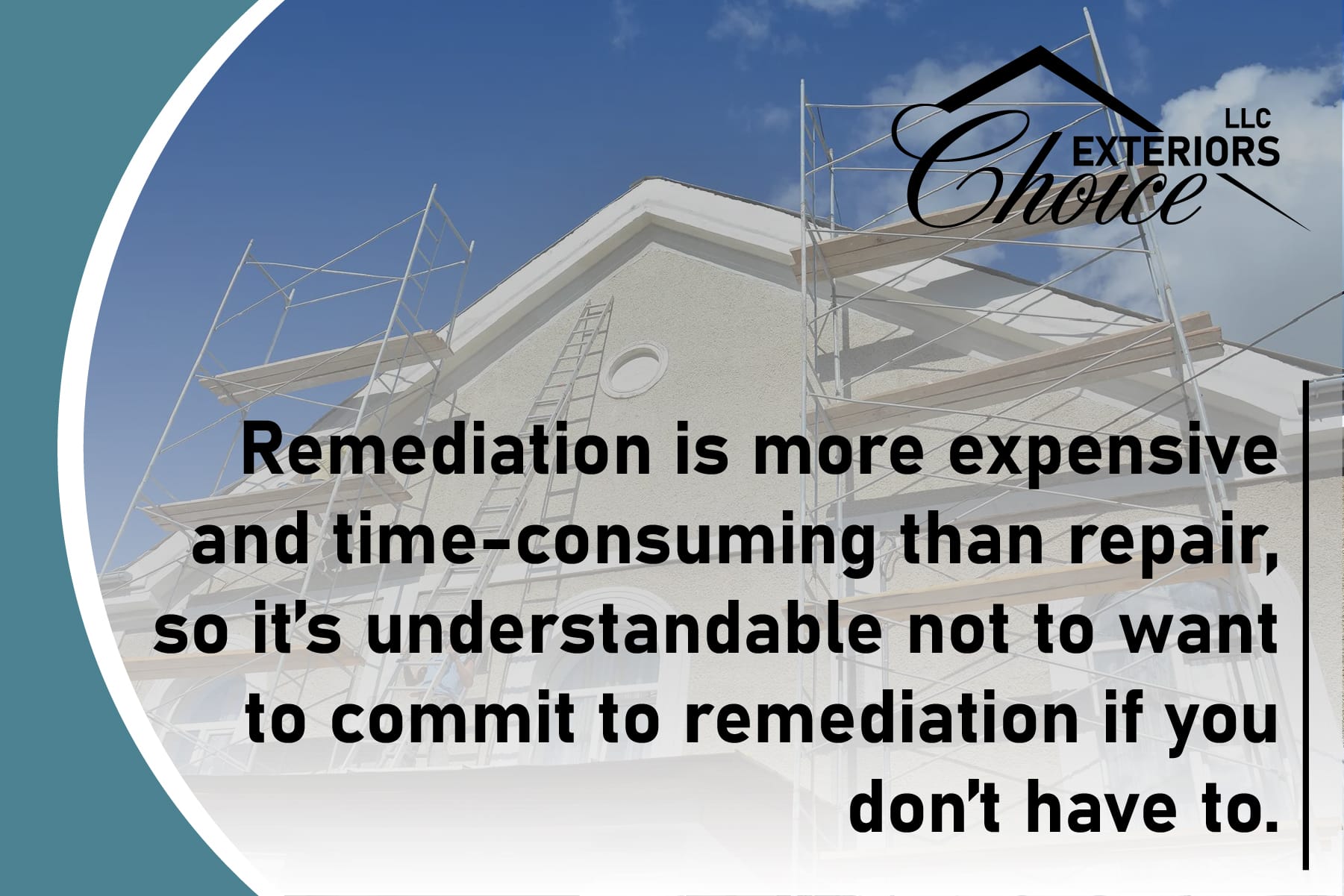
However, it’s more costly and inconvenient to postpone inevitable remediation with surface repairs.
If you are not sure if your home needs remediation, follow these steps:
1. Conduct a visual inspection
Do a quick assessment and check for signs of water damage and mold in vulnerable areas such as around windows, doors, and chimneys and look for these common signs:
- Black stains underneath windows or other places.
- Musky odors around the stucco, which could indicate mold or fungus.
- Crumbling, flaking, or cracking.
- Broken or shrunken caulking.
If you see these tell-tale signs of water damage, you should contact a pro to look into the matter further.
2. Contact a professional
Unfortunately, you may still have water damage behind your stucco even if there aren’t many visible signs of damage. If you are suspicious of water damage, contacting a professional may give you peace of mind since a professional can tell you beyond a shadow of a doubt whether your home is compromised. They can also give you guidance on whether you need repairs or remediation.
3. Contact a construction company
If it turns out that your home needs remediation, you should act immediately and contact a company that performs remediation as soon as possible. It is essential to find and destroy the root cause of the problem as quickly as possible, so it doesn’t spread and cause further damage.
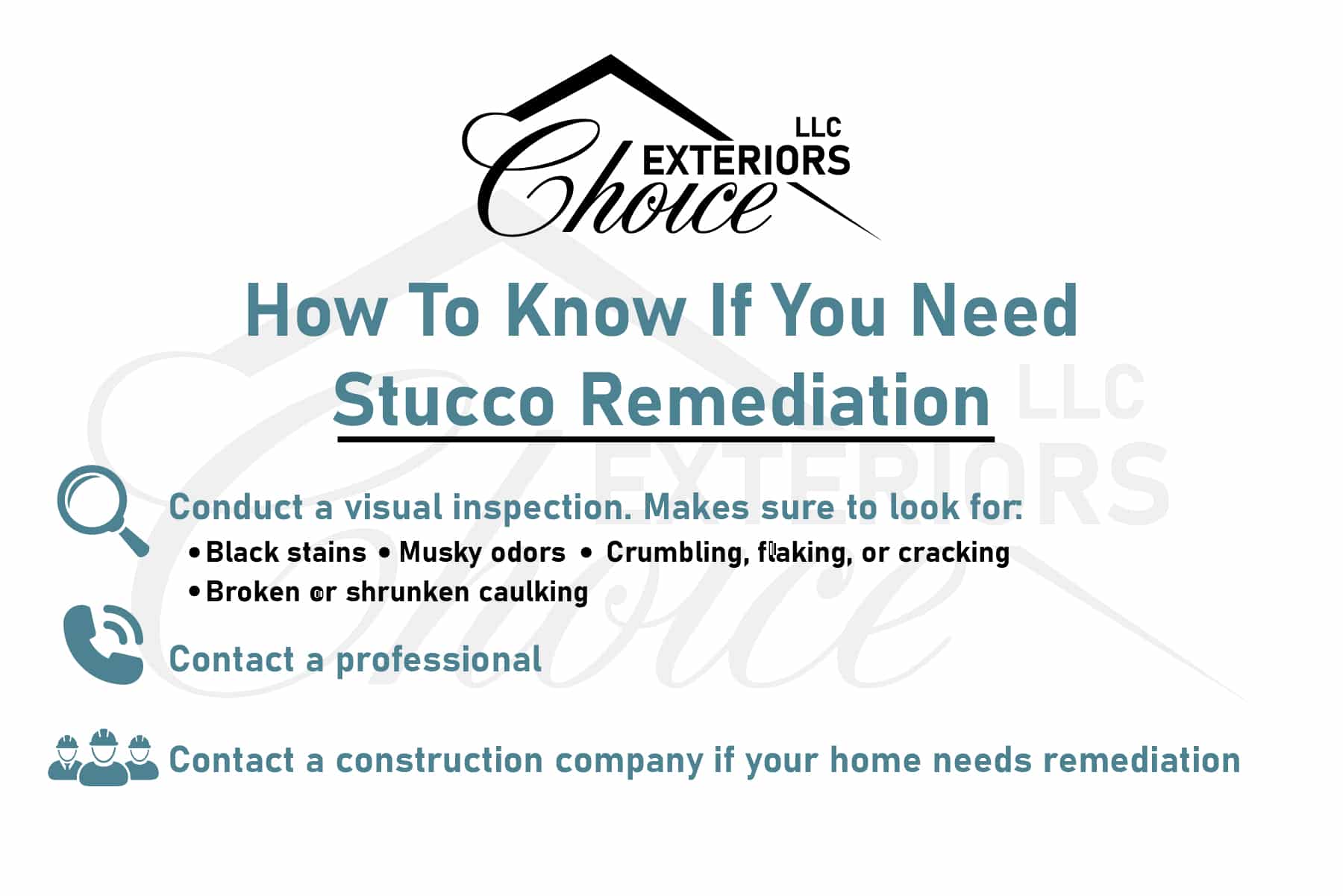
What happens if you ignore the problem?
If you see signs that there may be water damage behind your stucco, it is usually best to form a plan of action for fixing the problem as soon as you are able to. You don’t want the problem to get worse.
If you ignore the problem, the moisture behind the stucco continues to worsen. After a while, that moisture starts making unsightly stains on the exterior of your stucco. It can also seep through your walls and form stains on your interior drywall and ceilings.
It can also result in an infestation of nasty, toxic black mold. And mold is something you absolutely do NOT want in your home! Mold is unhealthy for people and can cause respiratory issues and, in some cases, even nausea and vomiting.
Beyond that, moisture damage causes the wooden components of your home to start rotting, which can seriously compromise the structure of your home.
You don’t want your forever home to be damaged like this! If you see signs of water damage, call a professional immediately.
The Stucco Remediation Process
If you decide to perform stucco remediation on your home, here is what the process looks like:
Step one should be a thorough examination by a professional to determine if there are any underlying issues in your house. If the professional discovers rot, mold, or structural issues, the remediation process will start with stripping away all the old stucco.
Once the outer layers of compromised stucco are gone, the builders can fix any structural issues or internal sources of damage that lay beneath. Once everything looks good again, the builders can apply new, upgraded stucco or siding to your home.
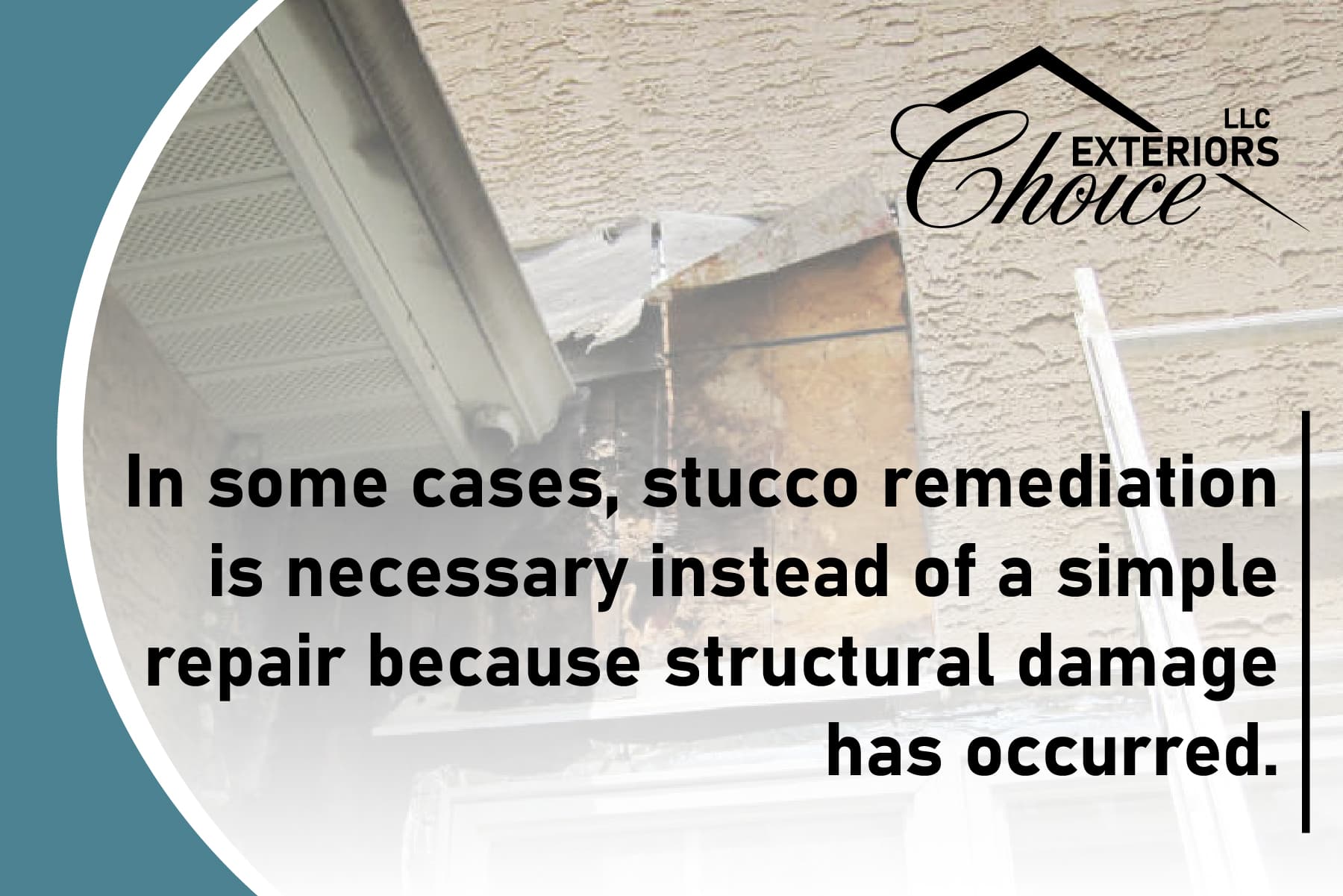
After the process is finished, you should have no further issues with the water damage.
How much does stucco remediation cost?
Various factors play into the cost of a stucco remediation job, and we can’t say precisely how much a job will cost until we have looked at it. However, here are a few of the factors that will influence the cost of your project:
-
Size of building
The larger the area to redo, the more it will cost. With a larger building, you may not have to replace all your stucco, but keep in mind that your stucco looks better if all of it is new.
-
Severity of damage
The worse the damage, the more time and money it will take to fix it. You usually can’t fully know how bad the situation is until you have all the old stucco off and can see the internal structure.
-
Number of windows
Windows and doors make a stucco job more complex. Therefore the more doors and windows there are on your building the more expensive the job will be.
-
Experience of the contractor
You get what you pay for, and a more experienced contractor will likely be more expensive than someone just starting out.
-
Type of stucco
There are two types of stucco: traditional and synthetic. Synthetic stucco tends to be more expensive than traditional stucco. You can also apply stucco in 3 layers or 1 layer, with 3-layer stucco being more costly and time-consuming than 1-layer stucco.
Another common question people ask is, “Will my insurance cover stucco remediation?”
That depends on your insurance company and the specific circumstances you find yourself in. If your stucco job was done by a licensed contractor and the damage was only recently discovered, chances are your insurance will pay for it. But most insurance companies will not cover damage on work done by non-licensed contractors, and it is true that insurance companies commonly reject stucco damage claims.
While it is impossible to know whether or not your insurance will cover the cost of stucco remediation, it never hurts to check!
Conclusion
Stucco damage is not a problem any homeowner wants to experience.
But if you are dealing with it right now, give us a call here at Choice Exteriors. We would be happy to help you out of your situation.
Besides stucco remediation, we also offer a variety of other home exterior services, including:
Give us a call today! We look forward to hearing from you.



This really provides a clear breakdown of the difference between stucco repair and remediation! Understanding the importance of addressing underlying issues to prevent future problems is crucial for homeowners. The potential benefits of stucco remediation, like improved weather resistance and a fresh look, are also very appealing.
It also mentions various factors that can necessitate remediation. Could you tell me more on some warning signs that might indicate it’s time to consider a more comprehensive remediation project, as opposed to simply patching up minor cracks?
Hi Joey, Thank you for reaching out to us through our blog post. I am happy to hear that we could help bring some clarification on the issue with stucco repair vs. stucco remediation.
Speaking into various factors that necessitate remediation, if you are seeing large cracks in your stucco, or maybe black or dark streak lines underneath your windows or rooflines, this can indicate water and moisture intrusion and poor flashing methods, allowing the water to freely enter the envelope of the home.
if you are seeing hairline cracks in your stucco but the stucco is maintaining its color, and not streaking through, a repair may be all that is necessary at this point.
I would be happy to jump on a call with you to discuss any specific project that you may be concerned about.
The blog post provides a comprehensive guide to stucco remediation, explaining what it is, when it’s necessary, and the process involved. It highlights the differences between stucco repair and remediation, emphasizing the importance of addressing underlying issues rather than just surface damage.